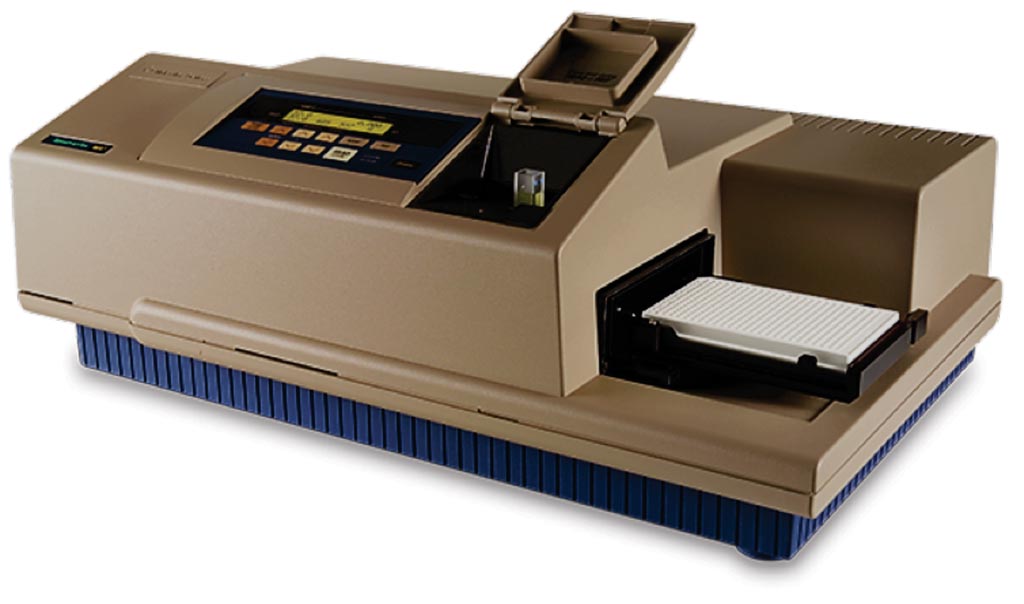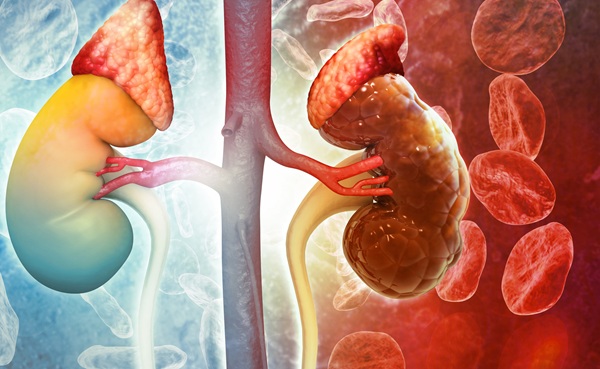Novel Rapid Test Developed for Detecting Carbapenemase
|
By LabMedica International staff writers Posted on 02 Apr 2020 |

Image: The SpectraMax M5 Microplate Reader is the standard for UV/visible multi-mode reader absorbance, providing ultrafast, full spectral range detection for cuvettes, 96-, and 384-well microplates (Photo courtesy of Molecular Devices).
As a potent β-lactamase, carbapenemase can degrade almost all β-lactam antimicrobial drugs, including the carbapenems, regarded as the last line of therapy for many life-threatening infections. If uncontrolled, the spread of these carbapenemases is expected to increase therapeutic failure and leave many patients with no effective treatment options.
Despite the urgency, timely carbapenemase detection remains a challenge for microbiology laboratories. Phenotypic assays are inexpensive and easily performed, but their use requires 24–48 hours and many lack sensitivity or specificity. The widespread use of other assays (e.g., molecular tests of carbapenemase genes, mass spectrometry detection of carbapenem hydrolysis) is impeded by the expertise required to perform them and their cost.
Scientists affiliated with the Massachusetts General Hospital (Boston, MA, USA) demonstrate that by using fluorescence identification of β-lactamase activity (FIBA), carbapenemase production in bacteria can be detected sensitively and specifically in 10 minutes, with only one step. FIBA uses a dark fluorescence probe, β-LEAF (β-lactamase enzyme–activated fluorophore), which turns fluorescent when cleaved by β-lactamases, including penicillinases, extended-spectrum β-lactamases (ESBL), AmpC β-lactamases, and carbapenemases.
The team tested FIBA on 76 randomly selected infection isolates. To start the assay, 25 μL of 1 × 1010 CFU/mL bacterial suspension made by colonies grown overnight on BHI agar is added to each well. To monitor the increase rate, fluorescence measurement is then performed at 37 °C at 10-second intervals for 10 minutes with Ex/Em 450/510 nm in the Spectramax M5 plate reader (Molecular Devices, San Jose, CA, USA).
Genetic test results for β-lactam resistance were provided with the isolates. Among these, 55 were carbapenemase positive, carrying the major epidemic carbapenemase types including Klebsiella pneumoniae carbapenemase, imipenem-hydrolyzing β-lactamase, metallo-β-lactamase, New Delhi metallo-β-lactamase, oxacillinase, Serratia marcescens enzyme, São Paulo metallo-β-lactamase, Verona integron-encoded metallo-β-lactamase, and New Delhi metallo-β-lactamase oxacillinase. The other 21 isolates expressed noncarbapenemase β-lactamases.
The authors concluded that FIBA can be performed ≈10 times faster than the most rapid carbapenemase test commercially available while maintaining comparable sensitivity and specificity. Its automated analysis improves turnaround time and reduces operator variability. With a reagent cost/assay of approximately USD 1.00, FIBA is close in price to phenotypic tests but substantially faster and less labor intensive. The study was published in the April, 2020 issue of the journal Emerging Infectious Diseases.
Related Links:
Massachusetts General Hospital
Molecular Devices
Despite the urgency, timely carbapenemase detection remains a challenge for microbiology laboratories. Phenotypic assays are inexpensive and easily performed, but their use requires 24–48 hours and many lack sensitivity or specificity. The widespread use of other assays (e.g., molecular tests of carbapenemase genes, mass spectrometry detection of carbapenem hydrolysis) is impeded by the expertise required to perform them and their cost.
Scientists affiliated with the Massachusetts General Hospital (Boston, MA, USA) demonstrate that by using fluorescence identification of β-lactamase activity (FIBA), carbapenemase production in bacteria can be detected sensitively and specifically in 10 minutes, with only one step. FIBA uses a dark fluorescence probe, β-LEAF (β-lactamase enzyme–activated fluorophore), which turns fluorescent when cleaved by β-lactamases, including penicillinases, extended-spectrum β-lactamases (ESBL), AmpC β-lactamases, and carbapenemases.
The team tested FIBA on 76 randomly selected infection isolates. To start the assay, 25 μL of 1 × 1010 CFU/mL bacterial suspension made by colonies grown overnight on BHI agar is added to each well. To monitor the increase rate, fluorescence measurement is then performed at 37 °C at 10-second intervals for 10 minutes with Ex/Em 450/510 nm in the Spectramax M5 plate reader (Molecular Devices, San Jose, CA, USA).
Genetic test results for β-lactam resistance were provided with the isolates. Among these, 55 were carbapenemase positive, carrying the major epidemic carbapenemase types including Klebsiella pneumoniae carbapenemase, imipenem-hydrolyzing β-lactamase, metallo-β-lactamase, New Delhi metallo-β-lactamase, oxacillinase, Serratia marcescens enzyme, São Paulo metallo-β-lactamase, Verona integron-encoded metallo-β-lactamase, and New Delhi metallo-β-lactamase oxacillinase. The other 21 isolates expressed noncarbapenemase β-lactamases.
The authors concluded that FIBA can be performed ≈10 times faster than the most rapid carbapenemase test commercially available while maintaining comparable sensitivity and specificity. Its automated analysis improves turnaround time and reduces operator variability. With a reagent cost/assay of approximately USD 1.00, FIBA is close in price to phenotypic tests but substantially faster and less labor intensive. The study was published in the April, 2020 issue of the journal Emerging Infectious Diseases.
Related Links:
Massachusetts General Hospital
Molecular Devices
Latest Technology News
- Machine Learning Models Diagnose ALS Earlier Through Blood Biomarkers
- Artificial Intelligence Model Could Accelerate Rare Disease Diagnosis
- AI Saliva Sensor Enables Early Detection of Head and Neck Cancer
- AI-Powered Biosensor Technology to Enable Breath Test for Lung Cancer Detection
- AI Model Achieves Breakthrough Accuracy in Ovarian Cancer Detection
- Portable Biosensor Diagnoses Psychiatric Disorders Using Saliva Samples
- Cell-Sorting Device Uses Electromagnetic Levitation to Precisely Direct Cell Movement

- Embedded GPU Platform Enables Rapid Blood Profiling for POC Diagnostics
- Viral Biosensor Test Simultaneously Detects Hepatitis and HIV
- Acoustofluidic Device to Transform Point-Of-Care sEV-Based Diagnostics
- AI Algorithm Assesses Progressive Decline in Kidney Function
Channels
Clinical Chemistry
view channel
POC Breath Diagnostic System to Detect Pneumonia-Causing Pathogens
Pseudomonas aeruginosa is a major cause of hospital-acquired and ventilator-associated pneumonia, particularly in lung transplant recipients and patients with structural lung disease. Its ability to form... Read more
Online Tool Detects Drug Exposure Directly from Patient Samples
Doctors often rely on patient interviews and medical records to determine what medications a person has taken, but this information is frequently incomplete. People may forget drugs they used, take over-the-counter... Read moreMolecular Diagnostics
view channel
Blood Biomarker Improves Early Brain Injury Prognosis After Cardiac Arrest
After a cardiac arrest, many patients remain unconscious for days, leaving doctors and families facing uncertainty about whether meaningful recovery is possible. Current tools to assess brain damage, including... Read more
Biomarkers Could Identify Patients at High Risk of Severe AKI After Major Surgery
Acute kidney injury is one of the most common and dangerous complications after major surgery, particularly among patients in intensive care. Even mild impairment of kidney function can lead to long-term... Read more
CLIA Test Identifies Head and Neck Cancer Recurrence from Post-Surgical Lymphatic Fluid
While the lymphatic system’s critical role in metastasis has long been recognized, routine access to patient lymph has been elusive. Now, a non-invasive process can access lymph through the collection... Read moreHematology
view channel
MRD Tests Could Predict Survival in Leukemia Patients
Acute myeloid leukemia is an aggressive blood cancer that disrupts normal blood cell production and often relapses even after intensive treatment. Clinicians currently lack early, reliable markers to predict... Read more
Platelet Activity Blood Test in Middle Age Could Identify Early Alzheimer’s Risk
Early detection of Alzheimer’s disease remains one of the biggest unmet needs in neurology, particularly because the biological changes underlying the disorder begin decades before memory symptoms appear.... Read more
Microvesicles Measurement Could Detect Vascular Injury in Sickle Cell Disease Patients
Assessing disease severity in sickle cell disease (SCD) remains challenging, especially when trying to predict hemolysis, vascular injury, and risk of complications such as vaso-occlusive crises.... Read more
ADLM’s New Coagulation Testing Guidance to Improve Care for Patients on Blood Thinners
Direct oral anticoagulants (DOACs) are one of the most common types of blood thinners. Patients take them to prevent a host of complications that could arise from blood clotting, including stroke, deep... Read moreImmunology
view channelBlood Test Could Detect Adverse Immunotherapy Effects
Immune checkpoint inhibitors have transformed cancer treatment, but they can also trigger serious immune-related adverse events that damage healthy organs and may become life-threatening if not detected early.... Read more
Routine Blood Test Can Predict Who Benefits Most from CAR T-Cell Therapy
CAR T-cell therapy has transformed treatment for patients with relapsed or treatment-resistant non-Hodgkin lymphoma, but many patients eventually relapse despite an initial response. Clinicians currently... Read morePathology
view channel
Rapid Low-Cost Tests Can Prevent Child Deaths from Contaminated Medicinal Syrups
Medicinal syrups contaminated with toxic chemicals have caused the deaths of hundreds of children worldwide, exposing a critical gap in how these products are tested before reaching patients.... Read more
Tumor Signals in Saliva and Blood Enable Non-Invasive Monitoring of Head and Neck Cancer
Head and neck cancers are among the most aggressive malignancies worldwide, with nearly 900,000 new cases diagnosed each year. Monitoring these cancers for recurrence or relapse typically relies on tissue... Read more
Common Health Issues Can Influence New Blood Tests for Alzheimer’s Disease
Blood-based tests for Alzheimer’s disease are transforming diagnosis by offering a simpler alternative to spinal taps and brain imaging. However, many people evaluated at memory clinics also live with... Read more
Blood Test Formula Identifies Chronic Liver Disease Patients with Higher Cancer Risk
Chronic liver disease affects millions worldwide and can progress silently to hepatocellular carcinoma (HCC), one of the deadliest cancers globally. While surveillance guidelines exist for patients with... Read moreTechnology
view channel
Machine Learning Models Diagnose ALS Earlier Through Blood Biomarkers
Amyotrophic lateral sclerosis (ALS) is a rapidly progressive neurodegenerative disease that is notoriously difficult to diagnose in its early stages. Early symptoms often overlap with other neurological... Read more
Artificial Intelligence Model Could Accelerate Rare Disease Diagnosis
Identifying which genetic variants actually cause disease remains one of the biggest challenges in genomic medicine. Each person carries tens of thousands of DNA changes, yet only a few meaningfully alter... Read moreIndustry
view channel
BD and Penn Institute Collaborate to Advance Immunotherapy through Flow Cytometry
BD (Becton, Dickinson and Company, Franklin Lakes, NJ, USA) has entered into a strategic collaboration with the Institute for Immunology and Immune Health (I3H, Philadelphia, PA, USA) at the University... Read more




















